5 Must-Have Rules For Clear&Effective Communication

There are several articles on communication tips, and unfortunately, none of them focuses on the articulation of complex topics where several findings need to be connected to explain the conclusion. I have read tons of them and studied them to improve my communication. It was only after I read “The Minto Pyramid Principle” that I realized that most of those “How to communicate better in 5 minutes” articles are crap and teaching you the wrong things.
Reading Barbara Minto’s book was an enlightenment for me. It is a 667 pages book that you need to study. However here I will tell you the main takeaways and it will help you a lot when designing your presentations. In this article series, I will focus on how you can create a “structured communication” by using the pyramid framework.
1. Do not talk in the same flow as you think
I am crazy about frameworks. If you apply the right framework, you know already what step you will follow and why. It saves you a great deal of time, even for the new problems. Someone tackled a similar one before several times and came up with certain steps that can help you! So it got me thinking if I can apply a framework to communication…
Structured communication and knowing your key message are essentials for conveying your message in an understandable and rememberable way, whether in a professional environment or in a casual one. On the other hand, human beings think in a chaotic way. We connect dots from different parts of our memory, and it is needed for creative thinking.
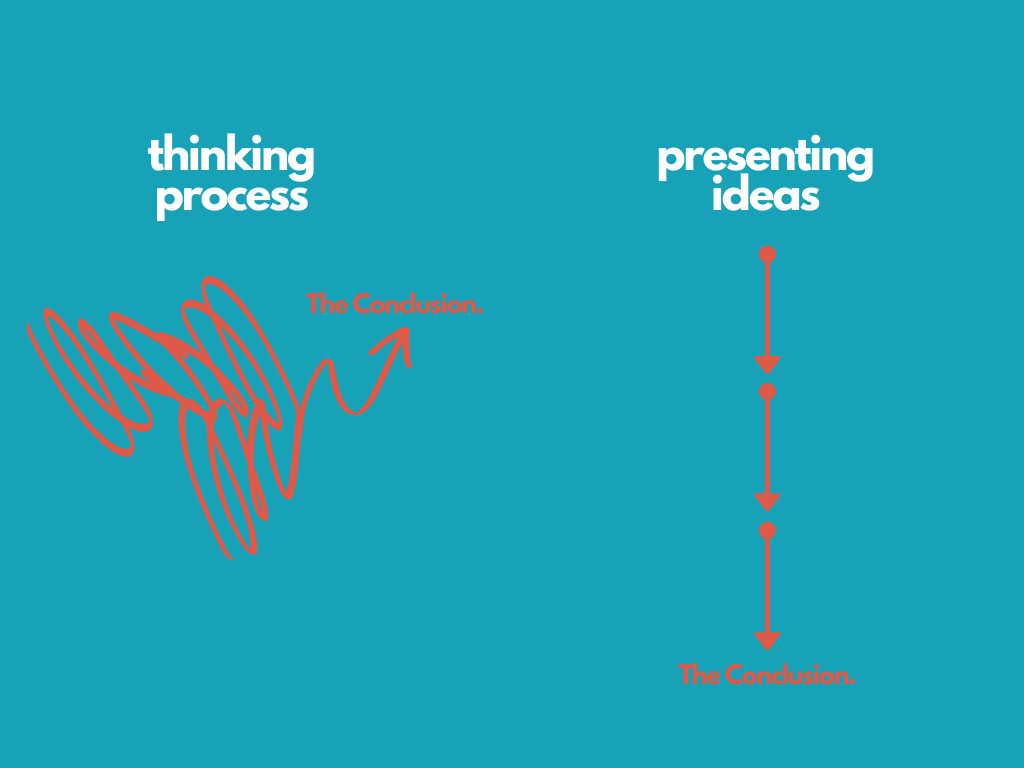
However, you cannot present your ideas in the same way. Stop just talking, and switching from point A to C then B then E. That can be your thinking process (which is called creative thinking or lateral thinking) and that is fine. However, you cannot communicate as you think. You should take your audience through your reasoning step by step, always one leading to another.
Put them in a linear order that will create a flow.
2. Put your points into an order
Most of the time there are multiple reasons leading to your next point, which means they have a connection among each other, like a chain. Now imagine your key point (which is your conclusion or your recommendation) as the summit and all other sub-points are the base of a pyramid.
Then, you can decide on moving top-down or bottom-up.
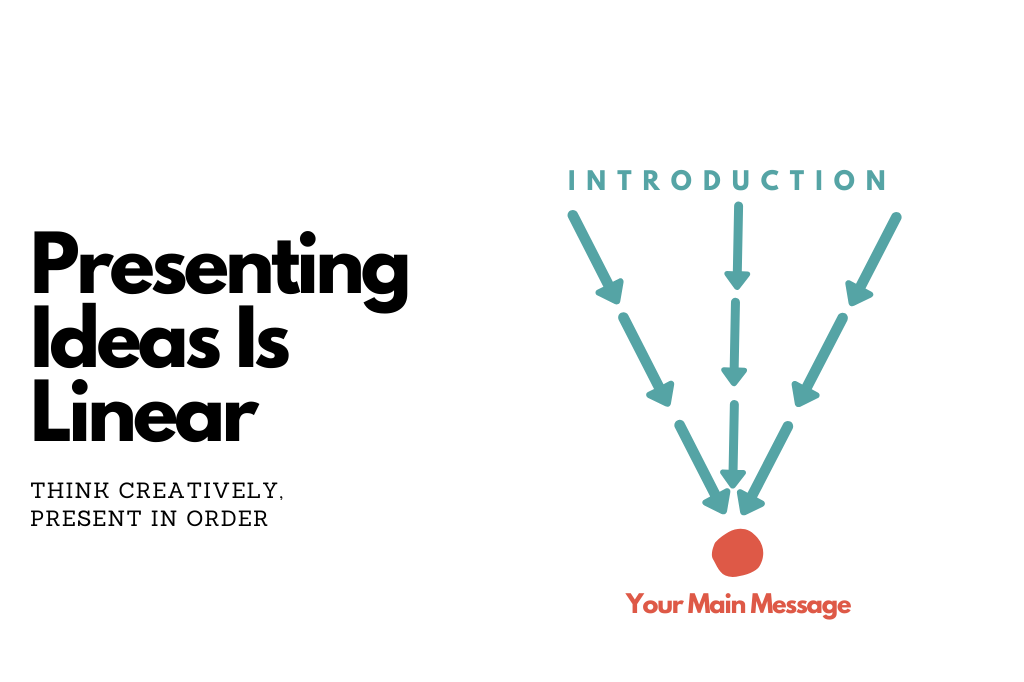
3. Create a pyramid schema of your thoughts
Most of the time there are several sub-points explaining your next point. If it is a simple topic you will have a flow similar to: “A -> B -> C”. For complex topics (which we encounter every time in a business context) it looks like “A1 + A2 + A3 -> Key Point of A’s” and “B1 + B2 + B3 -> Key Point of B’s” and “Key Point of A’s + Key Point of B’s -> C1” and so on. As it is seen in the graphic above, it looks like a pyramid. While putting your sub-points (which can be the reasons leading to your key message) try to create a pyramid-like hierarchy. It requires practice, so no worries if you are not able to do that immediately. In the next article, I will show you how to create a pyramid.
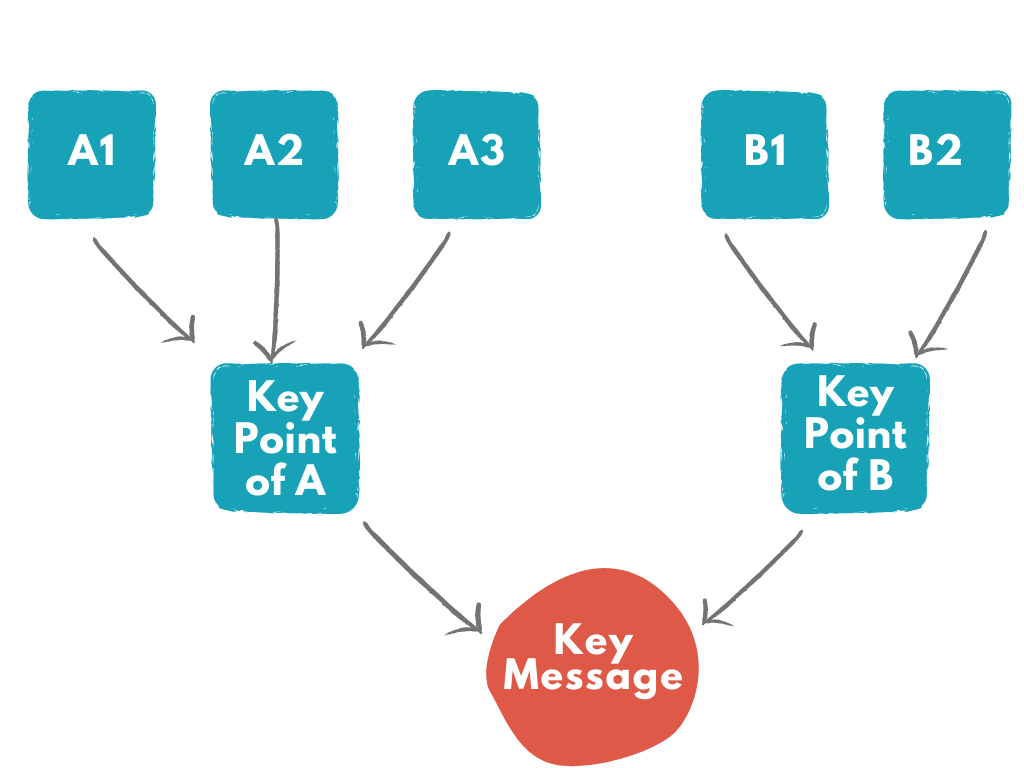
4. You are not a comedian so create a top-down pyramid
If you can see the pyramid above, that’s great! If not, no worries, I will explain how to create a pyramid soon. Let’s focus on the basics now.
Have you noticed that all the images are showing a top-down pyramid where the summit is at the end? Well, that is the important part. Imagine the top of the pyramid(summit) is your conclusion/key message and the bottom area represents all the reasoning and explanation of your key message. Now, let’s play with our pyramid. There are only 2 communication ways once you order your thoughts in a pyramid shape:
- Top- down pyramid (from key message towards the reasoning behind)
- Bottom-up pyramid (from reasoning towards the key message)
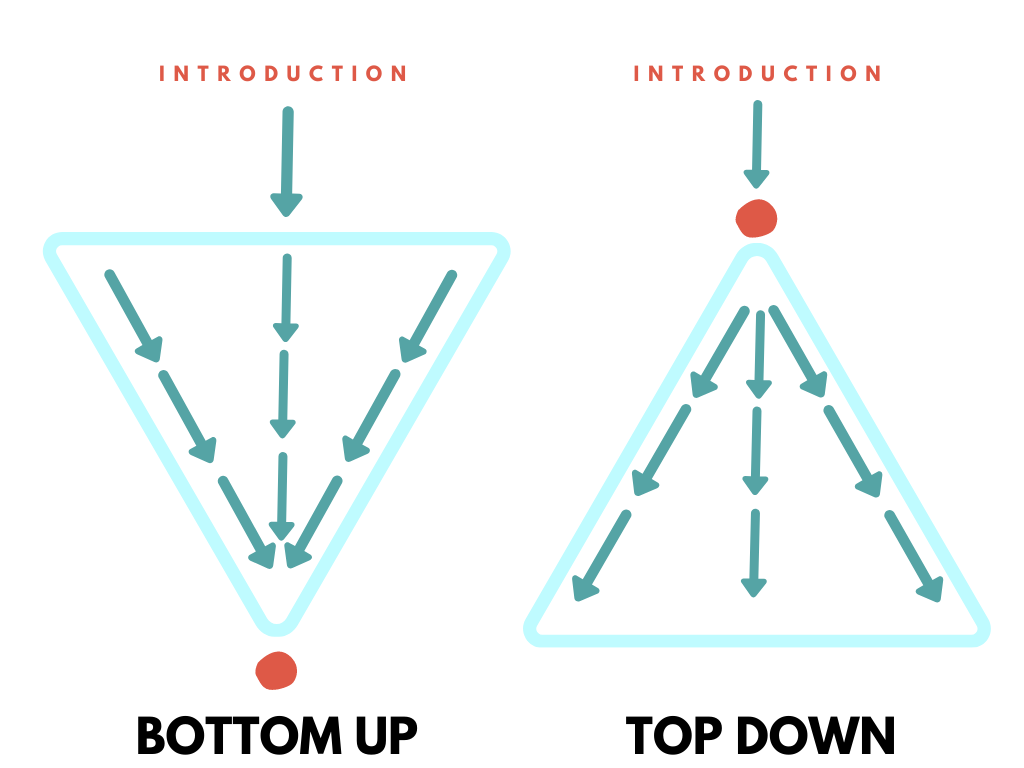
Most of the time you will be presenting something that is demanded from you.
- “We have a problem, give us a solution.”
- “We know the solution, but we do not know how to do it, give us a direction”.
Or you will be presenting to inform others about the problem and a solution:
- “I noticed this, and here is the solution.”
For these common cases, always pick the top-down approach in business life (and even in daily life).
Deliver the key point first, and tell the reasoning behind.
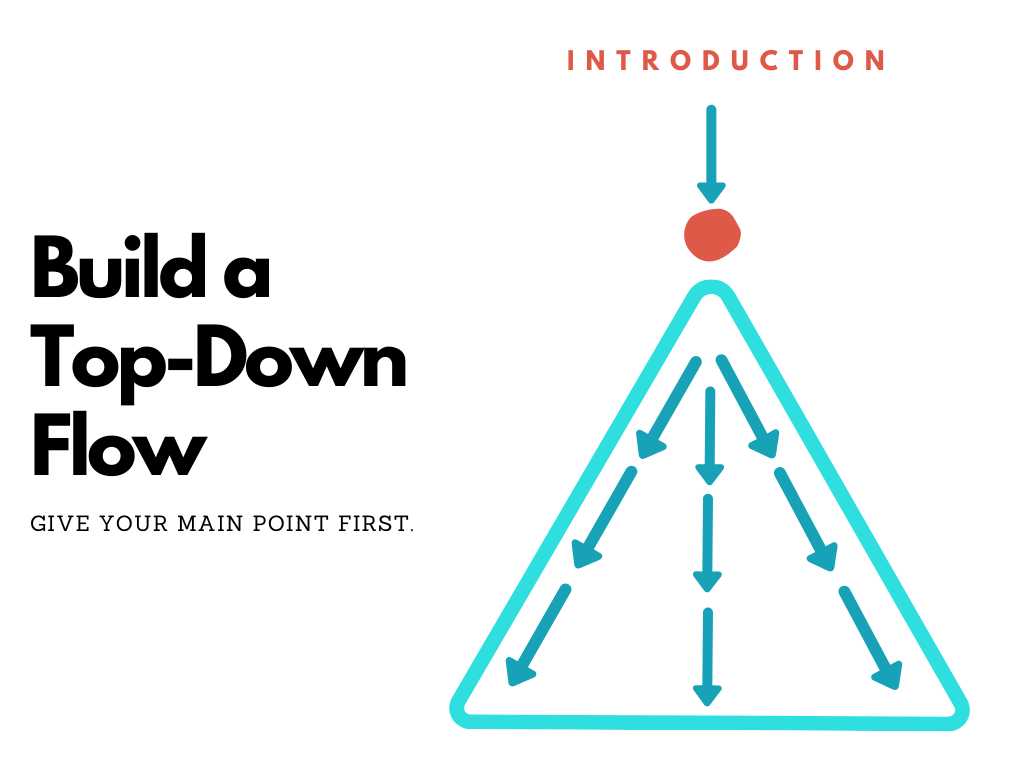
Let me help you with reason and reality…
None of us are really good storytellers or standup performers. Good storytellers are very hard to find and thus it is boring to listen to someone tell a story. It requires practice to manage to keep the excitement up all the time when the short attention span of human beings is considered. Your audience may stay in the room, but believe me, they are not listening.
If you are one of the good storytellers, then you are lucky but still, stick to the top-down approach in business. In professional life no one is interested in the process but the result. The sub-points have no meaning if the main point is not interesting. In addition to that, people have limited time, and what is important for you (your topic, your great solution) can be just a tiny issue in their pool of issues.
Wouldn’t it be better to convert your key message in the beginning when the interest is high? Then, give the main point (aka conclusion) first and then tell more about how you end up with it afterward.
In some cases, you will find yourself in a position where your key message is skeptical or wrong
(i.e: a conclusion that is very similar to what was already tried and failed) or a very controversial one? Then, you might put the audience on the opposite side immediately. This can increase their biased thinking, which would undermine every point you make during the “reasoning” presentation. The solution is preferring a bottom-up approach which will take them step by step to your conclusion, slowly without rising their shields in the beginning.
5. Never jump into the solution, before giving the context
Giving the conclusion first is the one thing you need to apply when presenting your ideas and solutions. However, don’t forget to remind the topic to the audience before delivering your key message. Remember again: What is important for you (the topic) might be a tiny issue in their world.
For reminding, you can follow the Situation-Complication-Solution (SCS) approach below.
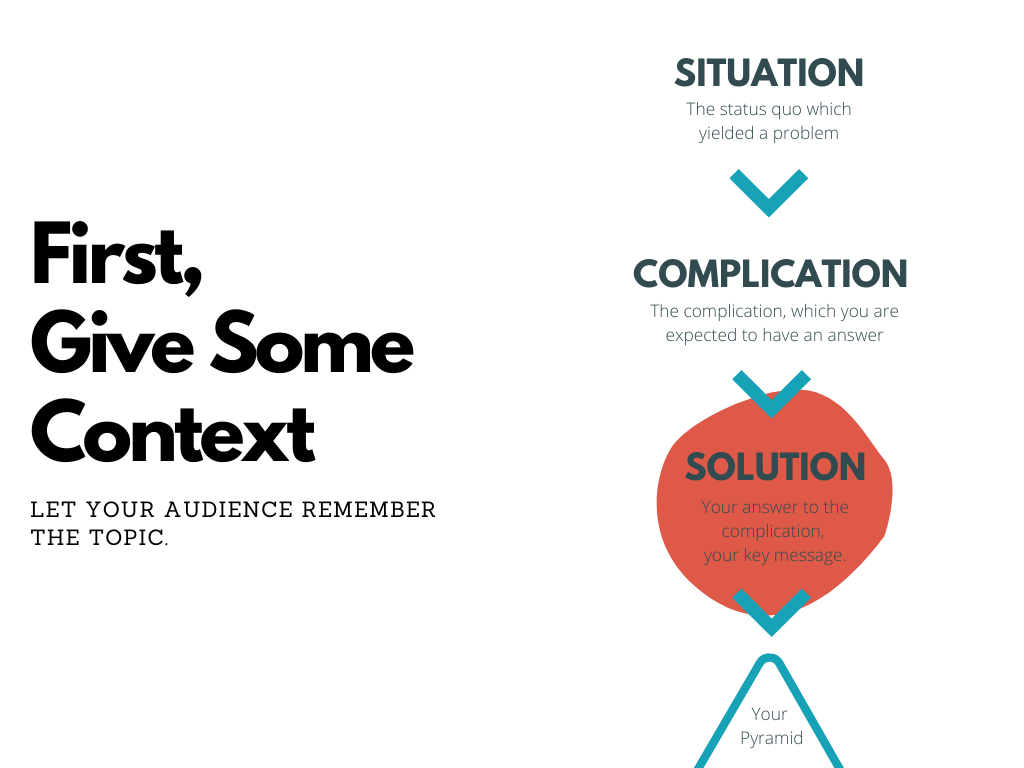
Situation: The current situation which yielded the problem (1–2 sentences). What is happening currently, what processes are in place.
Complication/Problem: In the current situation, something happened and because of that we have a problem where we need to bring a solution. This complication can be internal or external. (1–2 sentences)
Solution/Conclusion: And your solution for the problem (1–2 sentences)
Most of the time your audience will be aware of the situation and the problem (since they already demanded your work to solve the problem or improve the situation) so you shouldn’t keep this part long. Each part, including your key message, should have max. 2-3 sentences. An introduction should be literally only about reminding, not explaining. Everything you need to explain should go to the base of your pyramid.
Giving the conclusion first is the one thing you need to apply when presenting your ideas and solutions. However, don’t forget to remind the topic to the audience before delivering your key message. Remember again: What is important for you (the topic) might be a tiny issue in their world.
For reminding, you can follow the Situation-Complication-Solution (SCS) approach below.
NEXT: How to create a pyramid to present your ?
Till now, we learned how to construct a presentation that we need to remind what is happening to the audience and then state our conclusion/solution (if the topic is not too controversial).
In the second part, I will explain how you can organize your thoughts that they make a pyramid. Before starting practicing, read the 2nd part to learn about how you can create your pyramid.
(If you want to learn more about the pyramid approach I recommend reading The Pyramid Principle: Logic in Writing and Thinking: Logical Writing, Thinking and Problem Solving by Barbara Minto.)